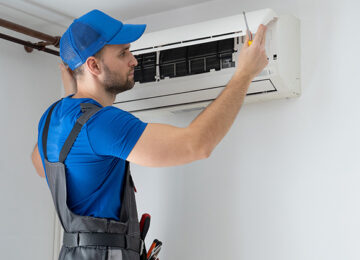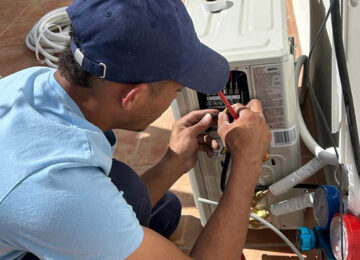In today’s world, air conditioners have evolved into sophisticated machines, offering a wide range of features designed to make our lives more comfortable. However, the electronic development of controlling your air conditioner can be overwhelming!
Air conditioning units come with various symbols and functions on their remote controls, and whilst they each serve a specific purpose, it can be a little confusing! In this blog, we will be exploring the essential air conditioner modes and functions to help you make the most of your cooling or heating system on the Costa del Sol.
To get you started, the basic functions are the easiest ones to understand.
ON/OFF Button: This button features a simple symbol that’s easy to understand. It’s the power switch for your air conditioning system, allowing you to turn it on or off as needed.
PLUS/MINUS Signs Button: These buttons are used to adjust the temperature settings. The plus (+) button increases the temperature by one degree, while the minus (-) button decreases it by one degree.
Next up: The different types of air conditioning modes.
Cool Mode: Represented by a snowflake symbol, the cool mode is the default setting for most air conditioning units. When activated, the air conditioner’s compressor starts to cool the room. Once the desired temperature is reached, the compressor switches off, and only the fan runs.
Fan Mode: This mode is indicated by a windmill symbol and is used to circulate cool air around the room. It doesn’t lower the temperature but provides a gentle breeze. Fan mode can save energy since it doesn’t engage the compressor.
Dry Mode: Quite contradictory but the dry mode is often represented by a water droplet symbol. It is helpful in humid conditions, hence the symbol. It reduces humidity levels in the room, making it more comfortable. Dry mode is suitable for moderately humid days when cooling isn’t necessary.
Heat Mode / Reverse Cycle Mode: Typically symbolised by various versions of the sun, this mode reverses the airflow within your air conditioning unit. It releases warm air into the room while expelling cold air outside. This mode is especially useful during the winter or colder months.
Auto Mode: Auto mode allows your air conditioner to automatically adjust its cooling or heating power based on changing room conditions. It helps maintain a consistent temperature and relative humidity.
Eco Mode: The eco mode is highly energy-efficient, using the compressor and fan efficiently to achieve the desired temperature with minimal energy consumption. Once the set temperature is reached, the compressor switches off, maintaining the temperature without unnecessary energy use.
Turbo Mode: Turbo mode runs the compressor and fan at higher speeds, quickly cooling or heating a space. Some manufacturers may refer to this mode as high power, jet mode, or power mode. It consumes a lot of energy so it’s not the most eco-friendly mode.
Apart from the different modes, there are a few different settings you can adjust your air conditioner to as well.
Fan Speed: You can adjust the fan speed to control how quickly your air conditioner cools or heats a room. Most units offer settings like low, medium, high, and auto, with auto-adjusting fan speed based on temperature changes.
Timer Setting: The timer allows you to schedule when your air conditioner turns on and off. This feature is helpful for automating your cooling or heating needs, such as turning on the AC before you get home from work.
Air Swing Control: Depending on your air conditioner, you may have the option to control the airflow direction. This can help distribute air more evenly throughout the room.
Quiet Mode: Some units feature a quiet mode, which runs the fan at minimal speed to create a quieter environment. This is especially useful in noise-sensitive settings, like bedrooms.
Cool Services: Your Air Con Supplier on the Costa del Sol
Understanding the variety of modes and functions of your air conditioner can help you use it efficiently and tailor it to your own needs. While there might be slight variations in symbols and features among different models, this guide should provide you with an understanding of the many different features of air conditioners.
If you have any specific questions about your unit or need air conditioning services, it’s always a good idea to consult your user manual or reach out to an air conditioning engineer.
The key to an efficient experience with your air conditioner lies in communication with experts who can assist with all your air conditioning service needs. Here at Cool Services, we have been operating on the Costa del Sol for over 16 years, so you can be assured that you’re in the best hands.
Our F-gas-certified engineers have extensive expertise in servicing a wide range of air conditioning units and climate control systems, spanning various brands and models. They are highly knowledgeable in optimising system performance and provide a first-class customer experience for all. Our service revolves around transparent pricing, meticulous attention to detail, and a steadfast dedication to delivering high-quality workmanship.

![Understanding Your Air Con Unit’s Modes and Functions In today’s world, air conditioners have evolved into sophisticated machines, offering a wide range of features designed to make our lives more comfortable. However, the electronic development of controlling your air conditioner can be overwhelming! Air conditioning units come with various symbols and functions on their remote controls, and whilst they each serve a specific […]](https://cool-services.com/wp-content/uploads/2023/09/Understanding-Your-Air-Conditioner-Modes-and-Functions.jpg)


